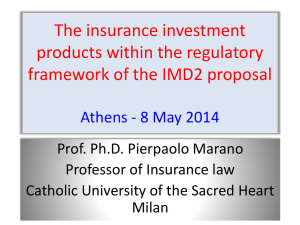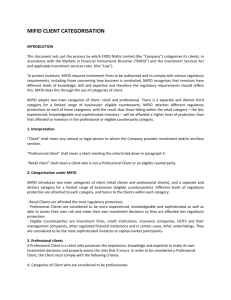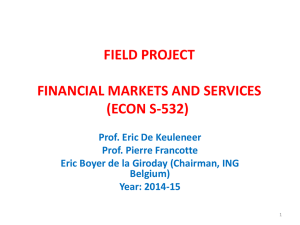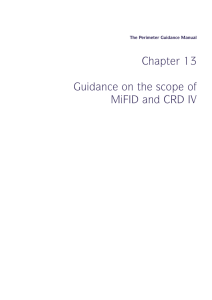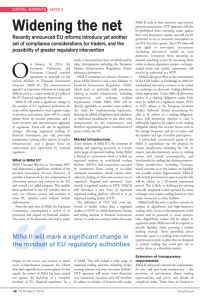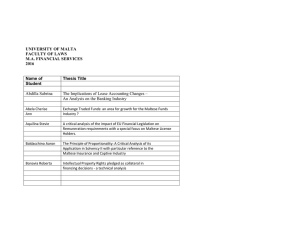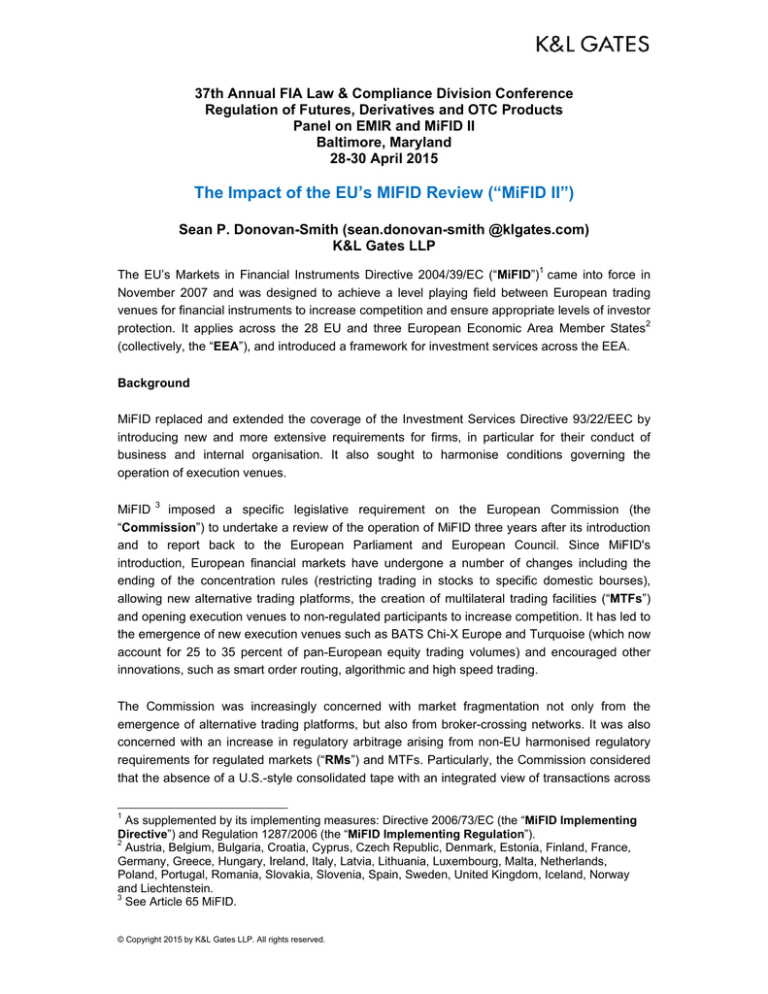
37th Annual FIA Law & Compliance Division Conference
Regulation of Futures, Derivatives and OTC Products
Panel on EMIR and MiFID II
Baltimore, Maryland
28-30 April 2015
The Impact of the EU’s MIFID Review (“MiFID II”)
Sean P. Donovan-Smith (sean.donovan-smith @klgates.com)
K&L Gates LLP
The EU’s Markets in Financial Instruments Directive 2004/39/EC (“MiFID”)1 came into force in
November 2007 and was designed to achieve a level playing field between European trading
venues for financial instruments to increase competition and ensure appropriate levels of investor
protection. It applies across the 28 EU and three European Economic Area Member States2
(collectively, the “EEA”), and introduced a framework for investment services across the EEA.
Background
MiFID replaced and extended the coverage of the Investment Services Directive 93/22/EEC by
introducing new and more extensive requirements for firms, in particular for their conduct of
business and internal organisation. It also sought to harmonise conditions governing the
operation of execution venues.
MiFID 3 imposed a specific legislative requirement on the European Commission (the
“Commission”) to undertake a review of the operation of MiFID three years after its introduction
and to report back to the European Parliament and European Council. Since MiFID's
introduction, European financial markets have undergone a number of changes including the
ending of the concentration rules (restricting trading in stocks to specific domestic bourses),
allowing new alternative trading platforms, the creation of multilateral trading facilities (“MTFs”)
and opening execution venues to non-regulated participants to increase competition. It has led to
the emergence of new execution venues such as BATS Chi-X Europe and Turquoise (which now
account for 25 to 35 percent of pan-European equity trading volumes) and encouraged other
innovations, such as smart order routing, algorithmic and high speed trading.
The Commission was increasingly concerned with market fragmentation not only from the
emergence of alternative trading platforms, but also from broker-crossing networks. It was also
concerned with an increase in regulatory arbitrage arising from non-EU harmonised regulatory
requirements for regulated markets (“RMs”) and MTFs. Particularly, the Commission considered
that the absence of a U.S.-style consolidated tape with an integrated view of transactions across
1
As supplemented by its implementing measures: Directive 2006/73/EC (the “MiFID Implementing
Directive”) and Regulation 1287/2006 (the “MiFID Implementing Regulation”).
2
Austria, Belgium, Bulgaria, Croatia, Cyprus, Czech Republic, Denmark, Estonia, Finland, France,
Germany, Greece, Hungary, Ireland, Italy, Latvia, Lithuania, Luxembourg, Malta, Netherlands,
Poland, Portugal, Romania, Slovakia, Slovenia, Spain, Sweden, United Kingdom, Iceland, Norway
and Liechtenstein.
3
See Article 65 MiFID.
© Copyright 2015 by K&L Gates LLP. All rights reserved.
Page 2
30 March 2015
the EU makes it difficult to assess best execution and impedes efficient price discovery. This is
exacerbated by the fact that MiFID transaction reporting requirements are not universal. The
Commission also considered that the emergence of non-transparent forms of trading such as
"dark pools" and closed "dark" crossing networks have the effect of drawing liquidity out of
regulated markets.
It is against this background that the MiFID review was conducted and its aim was to assess the
overall impact of MiFID and to make recommendations to the European Parliament to address
the structural changes touched upon above.
The Commission's Approach
During a public hearing held on 20 September 2010, 4 the Commission's then Single Market
Commissioner, Michel Barnier, set out four key principles for the MiFID review:
●
Greater transparency of all markets, such as the bond market and in particular
derivatives markets and the review of current pre- and post-trade transparency rules;
●
More responsible financial players;
●
Increased rules to ensure fair competition; and
●
The restoration of trust in the markets and financial intermediaries.
The MiFID review seeks to eliminate divergence across markets and financial instruments. For
example, MiFID currently provides for a broad waiver regime for trade transparency with various
options and discretions which have led to significant regulatory divergence. There has also been
divergent treatment in relation to financial instruments, notably in pre and post-trade
transparency requirements between equities and bonds and derivative products. Additionally,
packaged retail investment products (“PRIPs”) and some "new" complex products (such as
exchange traded funds and retail focused non-UCITS hedge funds) are not covered by existing
MiFID investor protection rules.
Consultation and legislative process
The Commission asked the Committee of European Securities Regulators (“CESR”), the
predecessor to the European Securities and Markets Authority (“ESMA”), to consult on possible
proposals and to provide the Commission with advice and recommendations.5 CESR conducted
4
See Revising the Directive on Markets in Financial Instruments - Speech by Michel Barnier, Member
of the European Commission responsible for the Internal Market and Services, SPEECH/10/459 of 20
September 2010 (in French).
5
The European Commission adopted a number of legislative proposals in September 2009 creating a
new regulatory architecture comprising a European System of Financial Supervisors (“ESFS”) and a
European Systemic Risk Board (“ESRB”). The new bodies became operational in 2011. The ESFS is
LO-#138963-v5-FIA_MiFID_II_Overview.docx
Page 3
30 March 2015
this consultation throughout 2010 and eventually completed two sets of technical advice to the
Commission that were published on 29 July, 2010 and 13 October 2010 respectively. 6 Broadly,
these covered: (1) market transparency, (2) equity market regulation, (3) transaction reporting,
(4) investor protection, and (5) over-the-counter (“OTC”) derivatives.
Following receipt of the CESR advice, the Commission published a consultation paper on the
MiFID on 8 December 2010. 7 The Commission eventually published legislative proposals on 20
October 20 2011 for MiFID II which would include a recast directive together with a new directly
applicable set of regulations - the Markets in Financial Instruments Regulations (“MiFIR”). 8
The process for adopting MiFID II is a legislative procedure called the “co-decision” procedure
that involves the Council of the European Union (the “Council”), the European Parliament (the
“Parliament”) and the Commission. MiFID II was subject to a significant amount of political
negotiation during 2012 and 2013 that led to a number of compromise proposals. On 14 January
2014, the Parliament announced that political agreement had been reached with the Council and
on 15 April 2014 the Parliament approved the draft texts of MiFID II. The Council formally
adopted the draft legislation shortly afterwards on 13 May 2014.
The implementation period for MiFID II commences once the Directive and MiFIR are published
in the Official Journal of the EU, which happened on 12 June 2014. Both came into force on the
twentieth day following publication and MiFID II’s 30 month implementation period began. As
such, MiFID II will now apply across the EU from 3 January 2017.9
As mentioned earlier the Level 2 measures for the Framework Directive comprise the MiFID
Implementing Directive and the MiFID Implementing Regulation.
MiFID II contains 106 separate implementing measures that will take the form of delegated acts
and technical standards. ESMA began the formal process of producing the implementing
measures by publishing a discussion paper and a consultation paper in May 2014 and ESMA
supported by three newly-created European Supervisory Authorities (“ESAs”): the European Banking
Authority (“EBA”), the European Insurance and Occupational Pensions Authority (“EIOPA”) and
ESMA.
6
In July 2010 CESR published its technical advice in respect of equity markets (CESR/10-802), nonequity markets transparency (CESR/10-799), transaction reporting (CESR/10-808) and investor
protection (CESR/10-859); in October 2010 CESR published its technical advice in respect of client
categorisation (CESR/10- 1040), post-trade transparency (CESR/10-882) and standardisation of OTC
derivatives (CESR/10-1096). For a compiled version of these papers, see CESR Technical Advice to
the European Commission in the context of the MiFID Review and Responses to the European
Commission Request for Additional Information - CESR, Technical Advice, 29 July 2010.
7
Review of the Markets in Financial Instruments Directive - European Commission Public
Consultation, 8 December 2010.
8
EU regulations are directly applicable across all EU Member States without further legislative action
by Member States. The Treaty on the Functioning of the European Union (“TFEU”) explicitly provides
that a regulation “shall be binding in its entirety and directly applicable in all Member States”.
9
MiFIR shall apply in all EU Member States from 3 January 2017 (subject to a small number of
excepted articles); the MiFID II Directive also applies from that date but, being a Directive, EU
Member States will need to take steps to transpose the requirements into their own national law (by 3
July 2016).
LO-#138963-v5-FIA_MiFID_II_Overview.docx
Page 4
30 March 2015
held public hearings in July 2014. This process culminated with technical advice being finalised
by ESMA and a further consultation in December 2014 (which closed on 2 March 2015).
Main impact areas of MiFID II
MiFID II can be broadly broken down into six key areas: (1) market transparency, (2) market
infrastructure, (3) transaction reporting, (4) investor protection, (5) OTC and commodity
derivatives, and (6) third country access. These key areas may be summarised as follows:
Market transparency
Investor protection
•
New pre-trade transparency rules for equities,
applying to shares, depositary receipts, exchange
traded funds, certificates and other similar
instruments traded on an MTF or Organised
Trading Facility (“OTF”).
• Requirement for investment advisers to make it
clear on what basis they provide advice, specifying
whether it is on an independent basis and whether it
is based on a broad or restricted analysis of the
market.
•
Extension of pre-trade transparency requirements
to non-equities, specifically bonds and structured
products admitted to trading on a RM, emission
allowances, and derivatives admitted to trading or
which are traded on an MTF or OTF.
• Restrictions on commission payments to firms
providing investment advice.
•
Extension of certain pre-trade transparency and
trading requirements to Systematic Internalisers
(“Sis”).
•
Introduction of a “consolidated tape”.
• National regulatory authorities and ESMA given
powers to prohibit or restrict marketing, distribution
or sale of certain financial instruments or types of
financial activity where there are significant investor
protection concerns, or a serious threat to orderly
functioning and integrity of financial markets or
stability of the financial system.
Market infrastructure
•
Introduction of a new category of OTF.
•
Introduction of systems and risk controls on
algorithmic traders.
•
Requirement for algorithmic trading strategies to be
in continuous operation during trading hours and to
post firm quotes at competitive prices.
•
Central Counterparties (“CCPs”) and trading
venues to be given right of access to trading
venues and CCPs respectively.
Transaction reporting
•
Widens the range of instruments subject to the
MiFID
transaction
reporting
obligation
to
transactions in all financial instruments traded on a
regulated venue.
• Introduction of rules on corporate governance,
including restrictions on the holding of multiple
directorships, and taking diversity into account.
OTC and commodity derivatives
• Derivative transactions declared subject to the
trading obligation to be concluded only on RMs,
MTFs, OTFs or certain third country venues.
• Rules to support liquidity, prevent market abuse and
provide for orderly functioning of commodity
derivatives markets.
• Introduction of power to introduce position limits, or
alternative arrangements with equivalent effect, on
the number of commodity contracts which any
person can hold.
• ESMA given intervention powers in order to
preserve market integrity and orderliness.
Third country access
• New rules and requirements for the establishment
of branches and the provision of services without a
branch by third country firms (also makes provision
for reciprocity and equivalence requirements).
LO-#138963-v5-FIA_MiFID_II_Overview.docx
Page 5
30 March 2015
We set out in more detail some of the key changes introduced by MiFID II.
Market Transparency
One of MiFID's key objectives was to promote competition between EU trading venues in order
to increase investor choice, encourage innovation, lower transaction costs, and increase the
efficiency of the price formation process on a pan-European basis. In order to achieve this, a
high degree of transparency is required to ensure a level playing field between trading venues
and to ensure effective price discovery. Fragmentation of markets impairs this process, dilutes
liquidity and penalises investors.10
MiFID II seeks to correct a number of issues related to transparency which are set out below.
Pre-trade Transparency Waivers Applicable to the Equities Market
There were concerns that "large in scale" waivers, reference price waivers, negotiated trade
waivers and order management facility waivers are being used by firms to create internal
crossing networks to execute orders on a "dark pool" basis, which may create an uneven playing
field. ESMA is given specific powers to monitor and review pre-trade transparency waivers.
Systematic Internalisers
MiFID introduced a specific regulatory regime for systematic internalisers (“Sls”) for the trading of
shares (which was intended to replace broker crossing networks). The core requirement imposed
on SIs is to publish firm quotes in shares that are classified as "liquid" under MiFID when dealing
in sizes up to standard market size.11 There have not been many SIs registered as such, which
has given rise to concerns about their status. MiFID II amends the SI quoting obligations to
make them more reflective of the type of business being undertaken. Particularly, Sls will be
required to maintain two-side quotes and a minimum quote size equivalent to 10 percent of the
standard market size of any liquid share in which they are an SI. The provision exempting Sls
from individually identifying themselves in post-trade reports if they publish quarterly trading data
is to be retained and SIs will be required to submit a periodic trading data report where they
make use of this exemption.
Post-trade Transparency
MiFID's post-trade transparency obligations apply to RMs, MTFs and investment firms. These
obligations are intended to promote price formation, assist in obtaining "best execution" and
mitigate any adverse effects from market fragmentation. The MiFID review process identified that
the quality of post trade transparency data has deteriorated significantly since MiFID was
10
Article 5 MiFID Implementing Regulation
See Article 27 MiFID. Standard market sizes are set out in Annex II, Table 3 MiFID implementing
Regulation
11
LO-#138963-v5-FIA_MiFID_II_Overview.docx
Page 6
30 March 2015
implemented, particularly in jurisdictions where all equity transparency information had been
previously published by the main market prior to the introduction of MiFID. CESR and the
Commission concluded that the deterioration was linked to investment firms that do not always
take appropriate steps to ensure that trade data is accurate and reliable (data from RMs and
MTFs is generally considered to be of high quality). As a consequence, MiFID II is introducing
formal measures for post-trade transparency in equity markets to improve the quality of data,
shorten delays for publication and reduce complexity.
Consolidated Tape
Difficulties have long been identified in establishing the best price for shares, an issue brought
about by market fragmentation. MiFID was expected to provide market participants with a way of
accessing a consolidated set of data across European exchanges and many data vendors now
deliver consolidated data. However, this consolidated data is not seen as being of a useful
standard for market participants (nor available at a commercially reasonable price). MiFID II
introduces a regime to facilitate consolidation and to create a “consolidated tape”.
Extension of Trade Transparency Requirements
MiFID II was expected to widen the types of instruments that would be subject to mandatory
MiFID obligations. In 2007 CESR concluded that regulatory intervention was not immediately
required in respect of post-trade transparency for the corporate bond market. However, following
the 2008 financial crisis, CESR recommended the extension of the post-trade transparency
regime to corporate bonds. The regime is to be extended further to all non-equity financial
instruments traded on RMs and MTFs, and post-trade transparency requirements are to be
extended to centrally cleared credit default swap contracts, asset-backed securities and
collateralised debt obligations for which a prospectus has been issued or which are admitted to
trading on a RM or an MTF.
Market Infrastructure
The Commission has taken the opportunity of MiFID II to address a number of micro-structural
issues in equity markets and their potential impact on the overall equity market structure.
Particularly, there have been concerns about the perceived uneven playing field between RMs
and MTFs and potential issues with internal crossing systems operated by broker dealers that
are currently outside the scope of MiFID.
Scope of MiFID and MiFID exemptions
MiFID II extends the scope of the MiFID) by extending the definition of investment services to
include OTFs, extending the definition of financial instruments to include emissions allowances
and restricting certain of the MiFID exemptions thus bringing more firms within scope, particularly
in respect of commodity firms and market makers.
LO-#138963-v5-FIA_MiFID_II_Overview.docx
Page 7
30 March 2015
MiFID currently includes certain exemptions for commodity derivatives dealers who deal on own
account, including market makers. These firms will continue to be exempt under MiFID II
provided that:
•
this activity is ancillary to their main business when considered on a group basis, and that
their main business is not the provision of investment or banking services or acting as a
market maker in commodity derivatives; and
•
the firm does not use high frequency trading strategies.
Firms may provide investment services to customers or suppliers of their main business (except
by executing client orders) provided that this is an ancillary activity to such business. Firms that
rely on this exemption must annually notify its regulatory authority (in the UK, the FCA), which
may also require supporting evidence of its eligibility for the exemption.
MiFID II also amends the current exemption for firms that deal on own account (except in
commodity derivatives or emissions allowances or derivatives with emission allowances as their
underlying’s) and the MiFID II exemption will not apply to firms that:
•
are market makers;
•
use high frequency algorithmic trading strategies;
•
execute client orders; or
•
are members or participants of an RM, an MTF or who have direct electronic access to a
trading venue.
Algorithmic and high-frequency trading
MiFID II (at Article 17) also introduces standards for execution venues including sponsored
access, co-location, tick size regimes and guidelines in respect of algorithmic and high-frequency
trading. Firms that engage in algorithmic trading will need to have effective systems and risk
controls in place, including business continuity plans. Algorithmic trading strategies will be
required to be in continuous operation during the trading hours of the venues used, and to post
firm quotes at competitive prices in order to provide liquidity on a regular and on-going basis.
These proposals would apply equally to the use of algorithmic trading in the context of highfrequency trading.
LO-#138963-v5-FIA_MiFID_II_Overview.docx
Page 8
30 March 2015
The requirements include:
•
Extension of licensing requirements to investment firms that are members of RMs or MTFs,
have direct electronic access to trading venues or that apply high-frequency algorithmic
trading strategies.
•
Additional regulatory disclosure requirements on the strategies of algorithmic traders.
•
Restrictions on direct electronic access/sponsored access to trading venue systems.
•
Appropriate systems and controls for investment firms engaged in algorithmic trading and
pursuing a market making strategy and the introduction of a liquidity obligation.
•
Trading venues to implement circuit breakers and robust controls.
RMs and MTFs
As mentioned above, the Commission considers that an uneven playing field has been created in
respect of RMs and MTFs. Although the MiFID provisions governing RMs and MTFs are broadly
similar, RMs are concerned that they are subject to more stringent and costly regulatory
requirements than MTFs. In some EU Member States additional requirements on RMs that go
further than the MiFID obligations were introduced. A key difference between the requirements
for RMs and MTFs operated by investment firms is the concept of a "proportionate approach" for
organisational requirements that apply to MTFs and the related discretion that may be exercised
by Member States in determining proportionality. 12 Consequently, MiFID II will extend the
requirements for RMs under Article 39(a) to (c) MiFID to investment firms or market operators
operating an MTF, to ensure that RMs and MTFs are subject to the same organisational
requirements.
Broker Crossing Networks
A number of EU investment firms operate systems that internally match client order flow.
Generally, these firms receive orders electronically, utilise algorithms to determine how they
should best be executed and then pass orders through their internal system. Investment firms
operating these systems are subject to conduct of business rules, including best execution
requirements, and they are required to provide post-trade transparency for OTC transactions in
any shares admitted to trading on an RM. There is a significant use of these systems and they
have been increasing in their share of trading, partly due to the fact that such systems are not
subject to the same levels of transparency as RMs and MTFs. MiFID II effectively stops the
12
Article 13(4) MiFID states that an investment firm shall take reasonable steps to ensure continuity
and regularity in the performance of investment services and activities and shall use appropriate and
proportionate systems, resources and procedures.
LO-#138963-v5-FIA_MiFID_II_Overview.docx
Page 9
30 March 2015
trading on broker crossing networks of equities that are subject to MiFID’s trading obligation.
Instead, these trades must be executed on RMs, MTFs, SIs or equivalent third country venues.
Organised Trading Facilities (“OTFs”)
Article 20 of MiFID II introduces the OTF as a new category of trading venue. In addition to, RMs
and MTFs, this will be a third type of multilateral system in which multiple buying and selling
interests can interact in a way that results in contracts. However, an OTF is limited to trading of
bonds, structured finance products, emission allowances, or derivatives. The definition of an
OTF does not include facilities where there is no genuine trade execution or arranging taking
place in the system (for example, bulletin boards and aggregation engines).
The execution of orders on an OTF is carried out on a discretionary basis and two different levels
of discretion may apply: (i) when deciding to place or retract an order on the OTF; and (ii) when
deciding not to match a specific client order with other orders available in the system at a given
time, subject to client instructions and best execution obligations. As such, an OTF operator is at
liberty to decide which orders it wants to match and may also facilitate negotiation between
willing buyers and sellers. As a result of this discretion, OTF operators will owe certain conduct
of business duties to its clients including the client best interests rule, appropriateness, best
execution, and order handling.
There are a number of restrictions imposed on OTFs under MiFID II including a ban from trading
against its (or its group’s) proprietary capital (as with RMs and MTFs) subject to an exception
with regard to sovereign debt instruments for which there is no liquid market. OTFs may not be
an SI and are prohibited from connecting with SIs, or other OTFs, in a manner that allows the
systems to interact.
Open access
To improve competition, MiFID II introduces an open access provision that requires all trading
venues (RMs, MTFs and OTFs) to establish transparent and non-discriminatory rules on
accessing their venues. MiFID II extends this concept to access to clearing and settlement
systems throughout the EU, regardless as to whether transactions have been concluded through
RMs. Trading venues are to have non-discriminatory and transparent access to CCPs including
non-discriminatory treatment by CCPs in terms of collateral, the netting of economically
equivalent contracts and cross-margining with correlated contracts cleared by the same CCP, as
well as clearing fees. Equally, CCPs will have a right to clear instruments traded on trading
venues on a non-discriminatory basis and trading venues and CCPs are to have nondiscriminatory access to information and licences from benchmark providers.
Transaction Reporting
Transaction reporting regimes that require transactions to be reported to regulatory authorities
were in place in many EU Member States prior to the introduction of MiFID. The MiFID regime
LO-#138963-v5-FIA_MiFID_II_Overview.docx
Page 10
30 March 2015
was implemented to ensure that all EU Member States had transaction reporting data to enable
them to detect and pursue suspected instances of market abuse, client abuse or other regulatory
breaches, and this transaction reporting regime is based on the reporting of executed
transactions and not on individual orders. However, because some transaction reporting regimes
pre-dated MiFID, there have been difficulties in achieving convergence and there was a need for
greater consistency of approach to the interpretation and implementation of MiFID. Accordingly,
MiFID II seeks to address issues such as: which firms are required to comply with the regime,
differing interpretations of key terminology and the need to harmonise standards for the use of
client and counterparty identifiers within a transaction report.
Investor Protection
A number of MiFID's provisions required the Commission to specifically review the effectiveness
of investor protection provisions such as telephone recording, record-keeping, best execution
obligations, and the use of tied agents.13 Consequently, MiFID II introduces provisions for:
1.
Enhancing execution data available to firms from executing venues to assist firms in
meeting their best execution obligations to their clients. This includes ensuring the
availability, comparability and consolidation of information concerning the quality of
execution across various execution venues.
2.
Clarification of the definitions of complex and non-complex products in relation to
appropriateness requirements, including whether structured UCITS funds and UCITS
funds that employ complex portfolio management techniques should be treated as
complex.
3.
Including advice through distribution channels within the definition of "investment advice"
by amending and expanding the definition of "personal recommendation" and clarifying
that advice about hedging of risks is also investment advice.
4.
Strengthening the rights of clients who trade OTC derivatives and other complex
products to request information prior to the transaction and introducing specific
requirements to ensure that products and services that are offered are compatible with
the needs of the client, that risks are managed and that sufficient information is provided.
Client Categorisation
CESR considered additional technical criteria to clarify the meaning of "other authorised or
regulated financial institutions," "locals," "other institutional investors" and public bodies
managing public debt14 and whether local authorities/municipalities can be treated as public debt
bodies. CESR recommends to the Commission that there should be some clarification of the
13
14
See Articles 44(5) and 51 (4) MiFID Implementing Directive and Article 65(3)(c) MIFID.
See Annex ll.l (1)(c), (h), (i) of MiFID and Article 24(2) and Annex 11.1(3) MiFID.
LO-#138963-v5-FIA_MiFID_II_Overview.docx
Page 11
30 March 2015
range of entities that fall within the current broad categories of per se professional clients in
respect of "other authorised or regulated financial institutions", "locals" and "other institutional
investors" and that the reference in MiFID to regional governments and public debt bodies
includes local authorities.
MiFID II has introduced certain amendments to client categorisations. Specifically, investment
firms may no longer treat municipalities and local public authorities automatically as professional
clients or eligible counterparties unless they have opted to be treated as such and the firm has
assessed them as having the requisite knowledge and experience. EU Member States have an
option to adopt additional criteria for the assessment of the expertise and knowledge of these
bodies upon a request to be categorised as a professional client.
CESR also considered whether for very complex products (such as asset backed securities and
non-standard OTC derivatives) the scope of the eligible counterparty categorisation should be
narrowed and standards should apply to transactions done with ECPs. CESR advised the
Commission that the client categorisation rules do not need to be changed in relation to OTC
derivatives or complex products, but CESR concluded that the standards that apply when dealing
with eligible counterparties are not set out clearly in MiFID and that it should be made clear that
when dealing with eligible counterparties firms have to: (1) act honestly, fairly and professionally;
and (2) communicate in a way that is fair, clear and not misleading.
As such, certain provisions of MiFID are now extended to certain client types and MiFID II
requires the following obligations to be extended to eligible counterparties:
•
to act honestly, fairly and professionally (but note that the obligation on a firm to act in
accordance with a clients’ best interests is not extended to eligible counterparties)
•
to communicate in a way that is fair, clear and not misleading;
•
to comply with certain information requirements when providing investment services; and
•
to provide periodic reporting.
Product governance
MiFID II also introduces a product approval process for firms that “manufacture” financial
instruments for sale to clients. The process must identify the target market for each product and
ensure that all relevant risks to that target market are assessed and that the intended distribution
strategy is consistent with the identified target market. Product manufacturers must take steps to
ensure their products meet the needs of the product’s target market and must also take
reasonable steps to ensure that distribution and marketing of the products are limited to the
identified target market. All such products should be subject to periodic review.
LO-#138963-v5-FIA_MiFID_II_Overview.docx
Page 12
30 March 2015
Investment firms which offer or recommend financial instruments (that they do not manufacture)
must ensure that they understand the products and the target markets that they are intended for.
Suitability and appropriateness
MiFID and MiFID II impose suitability requirements to advisory and portfolio management
services. Firms giving investment advice will be required to disclose whether they will provide the
client with an ongoing assessment of suitability of investments and periodic reports must be
provided to clients, including an assessment of the suitability of the investment portfolio. MiFID II
will require all firms providing investment advice to provide clients with a statement specifying the
basis on which investment recommendations were determined to be suitable for the client.
MiFID introduced appropriateness requirements that apply to non-advised services which is
partly dependent on the complexity of an investment product. MiFID II narrows the definition of a
“non-complex” product and accordingly the appropriateness test will apply:
•
to shares unless they are traded on a RM (or third country equivalent) or MTF and to shares
in a non-UCITS collective investment undertaking or that embed a derivative;
•
to bonds and other forms of securitised debt unless they are traded on a EM (or third country
equivalent) or MTF;
•
to all debt instruments with an embedded derivative or “incorporate a structure which makes
it difficult for the client to understand the risk involved”;
•
to structured UCITS funds; and
•
to structured deposits that “incorporate a structure which makes it difficult for the client to
understand the risk of return or the cost of exiting the product before term”.
Independent advice
Similar to the UK approach since 2012, MiFID II is introducing a requirement for firms to inform
their clients whether advice is being provided on an independent basis and whether such advice
is based on a restricted universe of different types of instruments. “Independence” is to be partly
determined on the basis of whether a firm’s advice is based on a wide diverse range of
investments.
MiFID II will also require a firm to demonstrate to its applicable regulator that individuals who
provide investment advice to its clients have (and continue to have) the necessary experience
and competence to do so.
LO-#138963-v5-FIA_MiFID_II_Overview.docx
Page 13
30 March 2015
Best execution
MiFID II amends the MiFID best execution obligation for investment firms executing client orders
by introducing requirements that the execution policy must be provided in sufficient detail and in
clear, easy to understand language and that firms must annually publish a summary of the top
five execution venues where they executed client orders in the previous year for each class of
financial instrument. Trading venues and SIs will be required to publish annual data relating to
the quality of execution of transactions, which must be available publicly and at no extra charge.
This should include information on price, costs, speed and likelihood of execution for individual
financial instruments.
Information requirements
Under MiFID II, investment firms will be required to provide appropriate information to clients in
relation to a number of matters, including proposed investment strategies and risks, the target
market that a financial instrument is intended for (in other words, retail or professional clients),
execution venues, costs and associated charges (including the cost of advice, cost of financial
instruments recommended to the client and any third party payments). Costs and charges can be
disclosed on an aggregated basis subject to providing more detail if requested by the client.
Telephone and electronic recording
Investment firms will need to take all reasonable steps to record relevant telephone
conversations, face-to-face meetings and electronic communications relating to actual or
proposed own account and client transactions. Clients must be notified that telephone
conversations will be recorded and records (which must be retained for a minimum of five years)
must be sufficient to establish the terms of any order placed by a client as well as to detect
potential market abuse. Such records will need to be available to clients on request and the
rights of EU Member State regulators to request records will be extended.
Commission payments
In the UK, the FCA has been steadily tightening its rules on the use of soft commission
arrangements, which has created tension with the safe harbours that exist in the United States.
This process began in 2006 and became stricter in 2014. Consumer protection is a central
theme for the Commission and the EU is now in the process of adopting on an EU-wide basis
many of the concepts introduced by the FCA in the UK as part of MiFID II to address the growing
complexity of services and products offered, ensuring consumer interests are safeguarded.
Broadly, the rules are split into rules that apply to the payment of inducements generally and
rules that apply to the use of dealing commission specifically:
•
Fees, commissions and non-monetary benefits received from or paid to third parties are
currently allowed in limited circumstances.
LO-#138963-v5-FIA_MiFID_II_Overview.docx
Page 14
30 March 2015
•
Under the new proposals, investment firms that provide advice on an independent basis or
provide portfolio management will be banned from accepting or receiving fees, commissions
or any monetary benefits paid or provided by any third party or a person acting on behalf of a
third party (for example, issuers and product providers) relating to the provision of the service
to clients (the UK has limited the payment of commissions in respect of advised services to
retail clients from 1 January 2013).
•
Minor non-monetary benefits may be allowed on the condition that they do not impair the
ability of investment firms to act in the best interests of their client (further measures are
expected to be introduced by ESMA to complement the changes, including provisions to
improve the quality of information provided to clients about inducements).
•
ESMA has proposed a fully unbundled model for both generic and bespoke research. The
FCA has confirmed that it will implement this approach and that it will ban bundled
commission and require investment firms to pay for research either at their own cost or
through the use of "research payment accounts" (“research payment accounts” are accounts
that would be pre-funded by a MiFID investment management firm’s clients; balances on
these accounts could then be used by the firm to pay for research). EU participants are
developing a new form of CSA to unbundle the cost of research and cost of execution, with
the executing broker retaining a set proportion of dealing commissions in a separate account
and directing payments to providers of investment research on the basis of indications
received from asset managers (Note that ESMA has stated that it is concerned this would not
entirely address potential conflicts of interest).
MiFID already contained requirements for third party payments (see Article 26(b) of the MiFID
Implementing Directive) regulating inducements that are broadly to be maintained in MiFID II.
However, MiFID II aims to strengthen the current MiFID requirements for third party payments
and benefits. To this end MiFID II distinguishes between the rules that apply to (i) the investment
services of portfolio management and investment advice on an independent basis, and (ii) to all
investment services.
The MiFID II rules on inducements rules at Article 24(9) state that investment firms are not
regarded as fulfilling their obligations (in respect of conflicts of interest) where they pay or are
paid any fee or commission, or provide or are provided with any non-monetary benefit in
connection with the provision of an investment service or ancillary service, to or by any party
except the client or a person on behalf of the client, other than where the payment or benefit: (i)
is designed to enhance the quality of the relevant service to the client; and (ii) does not impair
compliance with the firm's duty to act honestly, fairly and professionally in accordance with the
best interest of its clients.
LO-#138963-v5-FIA_MiFID_II_Overview.docx
Page 15
30 March 2015
The essential requirements for inducements to be legitimately paid by/to a third person (other
than payments by or on behalf of the client) are:
•
disclosure of the existence, the nature and amount of the fee, commission or benefit, or,
where the amount cannot be ascertained the method of calculating that amount prior to
providing investment or ancillary services;
•
the third party payment must be designed to enhance the quality of the relevant service to
the client; and
•
the third party payment must not impair compliance with the firm’s duty to act in the best
interest of the client.
ESMA has given further guidance on what “enhancing the quality of service to the client" might
mean. Third party payments will need to be justified by reference to additional services, or a
higher level of service.
However, ESMA's guidance states that on-going payments (for example, trail commission)
require an on-going service to be provided before they can be justified. Further guidelines are to
be published by ESMA prior to the implementation of MiFID II in January 2017.
Product intervention
MiFIR introduces formal product intervention powers at both the domestic and EU level which are
given to ESMA (in relation to financial instruments), the EBA (in relation to structured deposits)
and to EU member State regulators.
A national regulator may prohibit or restrict: (1) the marketing or distribution of a particular
instrument; or (2) any type of financial practice in, or from, that EU Member State. The regulator
may only take action if it is satisfied on reasonable grounds:
•
that there are significant investor protection concerns or a serious threat to the orderly
functioning and integrity of financial markets or stability of the whole or part of the financial
system;
•
existing regulatory requirements do not sufficiently address the risks and the issue would not
be better addressed by improved supervision or enforcement of existing requirements; and
•
the action is proportionate given the risk, sophistication of investors or market participants,
and the effect of the action on investors and the market participants.
Before exercising such power, the applicable regulator must consult with regulators in other EU
Member States that might be affected by the intervention and take into account whether any
LO-#138963-v5-FIA_MiFID_II_Overview.docx
Page 16
30 March 2015
action will have a discriminatory effect on the services or activities provided from another
Member State. Any ban/restriction can only last for a maximum of three months.
Both the EBA and ESMA have similar powers to those described above. Any product
ban/restriction can be exercised on an EU-wide basis or can be exercised in relation to a
particular EU Member State.
OTC and Commodity Derivatives
The Commission intends MiFID II to be one of the main elements of a greater reform of the
commodities markets. The Commission's plan of action includes (1) enhancing the transparency
of trades in order to provide a better framework for commodities markets; (2) introducing
legislative proposals on OTC derivatives; (3) review of the EU’s Market Abuse Directive to
achieve reforms of the commodities markets, so as to strengthen how they are controlled and
supervised; and (4) granting powers to ESMA to ensure the harmonisation of EU securities rules.
Emission allowances will become financial instruments for the purposes of the MiFID II.
However, the provisions outlined below on position limits refer to “commodity derivatives”, which
do not include derivatives on emission allowances.
Physically settled commodity derivatives covered in Section C(6) of Annex 1 of MiFID will be
extended to those traded on an OTF subject to an exception for wholesale energy products (as
defined in the EU’s Regulation on Energy Market Integrity and Transparency) that are traded on
an OTF and which must be physically settled.
MiFID II also contains a transitional provision in relation to the applicability of the EMIR clearing
and collateralisation obligations to derivatives relating to coal or oil that are traded on an OTF
and which must be physically settled.
Exchange trading obligation
MiFID II and EMIR will require OTC derivative contracts that are both cleared through a CCP and
deemed sufficiently liquid to trade on a trading venue.15 This interacts with the EU’s Markets in
Financial Infrastructure Regulations (“EMIR”) as the MiFIR trading obligation applies to non-intra
group transactions in clearing eligible and sufficiently liquid contracts when traded by
counterparties subject to EMIR.
MiFIR imposes the trading obligation on transactions concluded between:
•
15
financial counterparties as defined by Article 2(8) of EMIR (broadly investment firms and
credit institutions), and
See Articles 28-34 MiFIR.
LO-#138963-v5-FIA_MiFID_II_Overview.docx
Page 17
30 March 2015
•
non-financial counterparties subject to EMIR’s clearing threshold (referred to in Article
10(1b) of EMIR).
(Intra-group transactions and transactions covered by the transitional provisions of EMIR (Article
89) are not covered.)
The trading obligation will require counterparties in scope of the obligation to conclude relevant
transactions only on RMS, MTFs, OTFs or third country trading venues (subject to the
Commission’s decision on equivalence and reciprocity). The obligation will only apply to the
class of derivative contracts that has been declared subject to the trading obligation by the
Commission and listed in a public register set by ESMA.
Position limits
Article 57 of MiFID II introduces rules to support liquidity, prevent market abuse and to provide
for orderly functioning of commodity derivatives markets. The Commission is given the power to
set position limits (or impose other arrangements with equivalent effect) on the number of
commodity contracts that a market participant may hold. EU Member State regulatory authorities
are required to monitor and ensure that such limits are in place. MiFIR gives ESMA the power to
intervene to preserve market integrity and orderliness where there is a threat to financial stability
or to the functioning of commodities financial markets, or in circumstance where a EU Member
state regulatory authority has not taken sufficient measures.
Position reporting
Article 58 of MiFID II introduces position reporting for commodity derivatives, emission
allowances, and derivatives with emission allowances as the underlying. Each relevant trading
venue is required to make public a weekly report of the aggregated positions held by the different
categories of position holders (investment firms, investment funds, other financial institutions,
commercial undertakings or, in the case of emission allowances, operators with compliance
obligations under the EU’s Emissions Trading Directive) by contract type. The weekly reports
must include the number of long and short positions, changes since the previous report, the
percentage of total open interest by category and the number of position holders by category,
subject to de minimis thresholds. The trading venues are also required to provide its regulator on
at least a daily basis a breakdown of the positions of all position holders.
In order to monitor compliance with position limits, members or participants of RMs, MTFs and
OTFs must also report to the trading venue details of their positions held through contracts
traded on such venue and identify all clients involved (including where any underlying principals
of such clients).
An investment firm trading in commodity derivatives, emission allowances and derivatives with
emission allowances as the underlying outside a trading venue must, on a daily basis, provide its
regulator with a breakdown of its positions in commodity derivatives traded on a trading venue
LO-#138963-v5-FIA_MiFID_II_Overview.docx
Page 18
30 March 2015
and as well as any economically equivalent OTC contracts and must identify all clients involved
(including, where any, underlying principals of such clients).
Third Country Access
Articles 39-43 of MiFID II16 introduces various provisions in respect of access by third country
(i.e. non-EU/EEA) firms to EU markets. At the moment, each EU Member State has its own
regime and MiFID II is a step towards a pan-EU approach in respect of certain client types. To
address this, MiFID II creates a third country equivalence regime that will allow access by third
country firms to the EU when providing services to professional investors and eligible
counterparties on a cross-border basis. In order to be eligible, third country firms must register
with ESMA to provide services on a cross-border basis and the Commission must have decided
that the third country has rules and safeguards “equivalent” to those in the EU.17
National rules will also continue to apply until such time as an equivalence decision is taken and
EU Member States can continue to apply national rules for three years after an equivalence
decision is made.
MiFID II also permits EU Member States to opt to require third country firms to establish
branches when providing services to retail or elective professional clients. If an EU Member State
does impose a branch requirement, then authorisation criteria and conduct of business rules will
apply.
Next Steps
ESMA has until May of 2015 to complete its consultation work and final advice will be prepared
and presented to the Commission on MiFID II no later than December 2015.
EU Member States have until July 2016 to bring forward domestic legislation in respect of the
MiFID II Directive requirements that must be implemented from 3 January 2017. The related
regulations, MiFIR, are directly applicable and take effect automatically on 3 January 2017.
Firms with existing permissions under the MiFID regime are in scope of MiFID II and should
undertake an analysis of the proposed MiFID II changes to fully understand how MiFID II will
impact their operational models. In terms of market infrastructure, MiFID II is likely to create a
number of opportunities and challenges and it remains to be seen what effect MiFID II will have
on market competition, open access and transparency.
16
Supplemented by Articles 35-38 of MiFIR.
Third country equivalence also requires reciprocity by the third country and regulatory cooperation
agreements must be in place between ESMA and the competent authorities of the third country.
17
LO-#138963-v5-FIA_MiFID_II_Overview.docx

